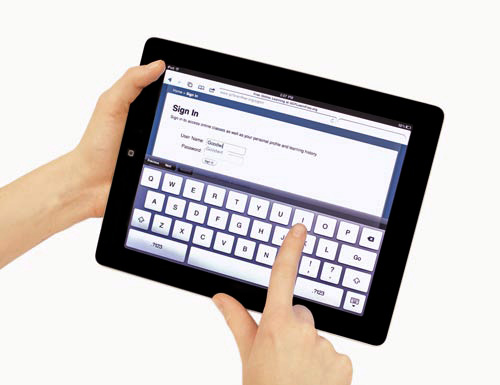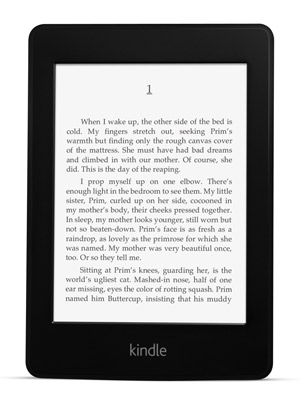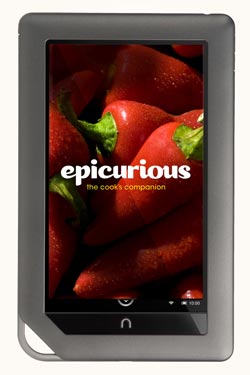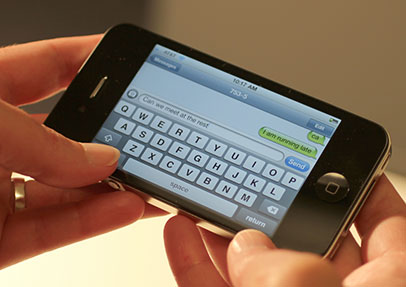Computer Basics
Getting to Know Mobile Devices
What is a mobile device?
A mobile device is basically any handheld computer. It is designed to be extremely portable, often fitting in the palm of your hand or in your pocket. Some mobile devices are more powerful, and they allow you to do many of the same things you can do with a desktop or laptop computer. These include tablet computers, e-readers, and smartphones.
Tablet computers
 Using a virtual keyboard on an iPad
Using a virtual keyboard on an iPadLike laptops, tablet computers are designed to be portable. However, they provide a different computing experience. The most obvious difference is that tablet computers don't have keyboards or touchpads. Instead, the entire screen is touch-sensitive, allowing you to type on a virtual keyboard and use your finger as a mouse pointer.
Tablet computers are mostly designed for consuming media, and they are optimized for tasks like web browsing, watching videos, reading e-books, and playing games. For many people, a "regular" computer like a desktop or laptop is still needed in order to use some programs. However, the convenience of a tablet computer means it may be ideal as a second computer. Below are some of the main features you can expect with a tablet computer:
- Mobile OS: Different types of tablets use different operating systems. Examples include Android and iOS. You'll usually be able to download free updates to your OS as they become available.
- Solid-state drives: Tablet computers usually use solid-state drives, which allow the computer to boot up and open programs more quickly. They are also more durable than hard disk drives.
- Wi-Fi and 3G/4G: Because they are optimized for Internet use, tablet computers have built-in Wi-Fi. For a monthly fee, you can also purchase a 3G or 4G data plan, allowing you to access the Internet from almost anywhere.
- Bluetooth: In order to save space, tablet computers have very few ports. If you want to use an external keyboard or other peripherals, they will often use a wireless Bluetooth connection.
E-book readers
 A Kindle e-reader with an e-paper display
A Kindle e-reader with an e-paper display A Nook Color with an LCD display
A Nook Color with an LCD displayE-book readers (also called e-readers) are similar to tablet computers, except they are mainly designed for reading e-books (digital, downloadable books). Examples include the Amazon Kindle and Barnes & Noble Nook.
E-book readers have either an e-paper display or an LCD:
- E-paper: Short for electronic paper, this type of display can usually only display in black and white. It is designed to look a lot like an actual page in a book. Unlike an LCD, it is not backlit, so the text stays readable even outdoors in full sun. Many people consider e-paper to be more pleasant to read because it causes less eye strain. However, it generally can't be used for videos or other applications because the refresh rate is too low.
- LCD: This is the same type of screen found on tablet computers and laptops. It's more versatile than e-paper, but it's often more difficult to view in bright sunlight, as the image becomes washed out. Since an LCD screen can display colors, this type of e-reader is better for viewing magazines or books with photos. Many LCD e-readers (such as the Nook Color) are basically tablet computers, as they can perform many different tasks in addition to displaying e-books.
You don't need an e-reader to read an e-book. E-books can usually be read on tablet computers, smartphones, laptops, and desktops.
Go to the Kindle and Nook websites to compare the features of different e-readers.
Smartphones
 Using an iPhone
Using an iPhoneA smartphone is a powerful mobile phone that is designed to run a variety of applications in addition to providing phone service. Smartphones are basically small tablet computers, and they can be used for web browsing, watching videos, reading e-books, playing games, and more.
Smartphones use touchscreens and operating systems similar to those used by tablet computers. Many of them use a virtual keyboard, but others have a physical keyboard, which allows the entire screen to be used for display purposes.
Internet access is an important feature of smartphones. Generally, you will need to purchase a 3G or 4G data plan in addition to normal cell service. Smartphones can also connect to Wi-Fi when it is available; this allows you to use the Internet without using up your monthly data allotment.
A personal digital assistant (PDA) is a mobile device that is used for managing phone numbers, addresses, calendars, and other information. Before smartphones existed, a PDA was usually a separate device. Today, smartphones combine the functionality of a PDA and a mobile phone.
Challenge!
- Think about how a tablet computer is different from a laptop. What are some of the advantages and disadvantages of a tablet computer?
- If you're thinking about buying an e-reader, think about what kinds of things you like to read. Do you mostly read books or magazines? What kind of screen do you think would be best?
- Smartphones can have virtual keyboards or physical keyboards. What are some advantages and disadvantages to each one?


